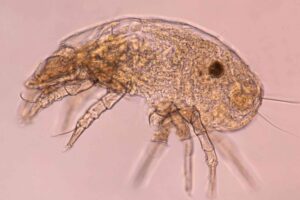One of the things that you don’t want to find in your kitchen is mites. Their presence in your grain is alarming. In this article, I’ll discuss mites in the kitchen – how to get rid of them.
If you find mites infesting your kitchen, you can get rid of them using water and vinegar. Mix two parts of water with one part of vinegar to make a natural mite repellant. Clean the places where you find mites with this mixture. These mites thrive in humid and damp places. So, make sure your kitchen storage areas are always dry.
If you want to kill these mites instantly, you can use aerosols and insect sprays that contain synergized pyrethrins. When this insect killer comes in contact with these pests, it will instantly kill them. But the effects are only good for a few hours.
Read on to learn more about the mites you can find in your kitchen and how you can effectively eliminate them.
Mites in the Kitchen

Thrive in Humid and Damp Places
Just like most homeowners, you will find mites in your kitchen from time to time. These tiny pests thrive in humid and damp places. So they commonly frequent areas in the kitchen.
Use Natural and Commercial Repellants
You can use natural and commercial repellants to get rid of them. With water and vinegar, you can make a natural repellant. Just mix two parts of water with one part of vinegar, and use this mixture to clean the places where you find these tiny pests congregating.
Use Neem Oil
If you can buy neem oil, that’s also a good natural mite repellant. Mix ten parts of water with one part of neem oil, and spread it to places where the mites have invaded. And since these pests love humid and damp places, you can use a hair dryer to dry the places where you find them.
Buy Insect Repellants with Synergized Pyrethrins
If you want a more convenient and easy way to get rid of these mites, you can buy insect repellants in aerosols or spray cans that contain synergized pyrethrins.
This chemical will kill the mites instantly when they come into contact with it. However, the substance’s effect will last only a couple of hours.
Insecticide Sprays with Bifenthrin or Permethrin
If you want an insect repellant that stays effective for several weeks, buy insecticide sprays containing bifenthrin or permethrin. These insect repellants retain their mite-killing power longer than those containing synergized pyrethrins.
Check the Food Before Storage
What you need to be concerned about is where these kitchen mites come from? You were the one who brought them into your home. This usually happens when you buy bread, flour, cereals, and other bottled or canned goods with mites or larvae.
So, it is best to check the contents of the food that you bought from the grocery. They may contain these pesky pests, but you are unaware of them.
Every time you buy pet food, bird seed, dried fruits, and whole-grain, check for mites after opening their package.
Weevils and Flour Mites
The most common mites that infiltrate your kitchen are weevils and flour mites. You will find them in your pantry and cupboards if you are not careful.
They love dark, damp, and humid places, which is what most kitchen cupboards and pantries are like. Mites breed profusely under these conditions.
What Are These White Things on My Bed?
What Kinds of Mites Can Invade Your Kitchen?
Several types of mites can infest your kitchen. If you want to prevent them from taking a foothold in your kitchen, you need to know what their types are. As I’ve just mentioned, most mites that you will see converging in your kitchen are weevils and flour mites:
1. Weevils
Weevils are different from flour mites. While they are also small but a bit bigger than flour mites. As such, they are easier to spot than flour mites. Weevils have darker body colors, which are typically brown.
They belong to the family of beetles having oval-shaped and slender bodies. Their bodies are also covered with scales and shiny hairs. Weevils have very distinctive noses that are 3 to 10 millimeters long and snout-shaped.
2. Flour Mites
Flour mites generally are smaller than weevils, but both act almost the same way. As their name suggests, you will usually see these mites infesting flour powder, cereals, and wheat grains.
But they are so small that you must strain your eyes to see them. The reason is that their body color is usually white. But you can still see them because their brown-colored legs will give them away.
3. Other Kinds of Mites
Other kinds of mites can infest your kitchen.
Grain Mites
Grain mites, also known as Acarus siro, are found chiefly in whole wheat flour, processed cereal products, and even cheese products.
Parasitic Mites
These mites are harder to detect because of their very small sizes. High-powered microscopes can detect them. But when you see their infestation, that’s the clue that they are present in your home.
These mites can come into your home because of the products you brought from the grocery store. Perhaps the flour, cereal, or whole wheat grain you bought from the store contains only a few of these mites.
However, they can lay eggs on the products where they came in. If you do not use the product immediately and store it in your pantry for several weeks or months, their eggs will hatch. Pretty soon, you will have a mite infestation in your kitchen.
During summer, heat will increase the reproduction rate of these mites. This will make your mite infestation much worse. So, it is best to buy flour, grains, and cereal products from reputable stores.
Tiny Ants in the Kitchen: How to Get Rid of Them
Is Eating Flour with Mites Safe?

Harmless to Humans
Flour mites and weevils are harmless to humans. They don’t sting, bite, or poison and are not even dangerous to touch. But what about flour and grain products with weevils and flour mites – are they safe to eat?
Nothing can happen to you if you eat flour and cereal products contaminated with flour mites, weevils, and other grain mites.
In the past, before you knew of this kind of infestation, you most probably have eaten flour produce that was contaminated with these mites, and nothing bad happened to you. You were not aware of it.
If you baked bread using this flour, the cooking temperature would also have cooked these small mites, making the bread or the dish you cooked safely to eat.
Weed Out the Mites Before Cooking
That being said, it is still a good practice to weed out these mites, if you ever find them, on the flour and other cereal and grain products before baking them or cooking them. You must also ensure they will not make your kitchen their breeding grounds.
Spread of Fungal spores
One consequence of tolerating weevils and flour mites is the spread of fungal spores. This could lead to mold and mildew growth inside your kitchen. Mold and mildew can get you sick. So, even if flour mites and weevils can’t get you directly ill, they still can – indirectly.
Allergy
Some people are also allergic to mites. If you are one of them, they can make your skin itch. Some people, although very rarely, have experienced swelling of their throats, leading to difficulty breathing just because they unknowingly consumed these mites.
Again, how to get rid of mites in the kitchen? Transfer uninfested food to another location. Clean your pantry using hot water and soap or a bleach solution. Hot water helps kill mites. Note that you should wash your rag every time you use it to clean your pantry.
How to Get Rid of Mites in the Kitchen
If you want to get rid of grain mites in the kitchen once and for all, you should follow a certain procedure. The process involves detection, eradication, and prevention. Here are the details of this process:
1. Look for Mite Dust
If a mite infestation occurs in your kitchen or pantry, you will see mite dust on their surfaces. The dust color is usually brown, so that it will look like sand. This dust is the collection of living and dead mites and their wastes.
2. Check for Minty Smell
Get some of the dust and rub it between your fingers. If it smells minty, it means there is a mite infestation in your kitchen. When you crush flour mites, they will emit a distinct minty smell.
You can also determine if mite has infested your flour and other cereal products and if the food smells or tastes sickly sweet.
3. Put Salt on the Flour and Wait for 15 Minutes
Pour some flour powder on a plate and put some salt on it. Smoothen the flour to have an even level throughout the plate. Then wait about 15 minutes. If there are mites in the flour, they will be forced to move around and make the top surface of the flour uneven.
4. Use Scotch Tape
Get scotch tape and stick it on cereal, flour packages, or pantry shelves. Then wait for mites to show up. They will stick to the tape; no matter how small, you will see them if you use a magnifying glass.
5. Observe the Reaction of Your Skin
It will show on your skin if you are allergic to mites and mite dust. So, observe your skin’s reaction after touching mites or dust. Your skin will itch if you are allergic to them. This skin condition is called ‘grocer’s itch.”
6. Discard Severely Contaminated Foods
If you have seen enough proof that mites have infested your foods, place them in plastic bags. Tightly seal these plastic bags and throw them in the garbage can outside your home.
7. Freeze Contaminated Food
You can also freeze the contaminated flour and cereal products. This will kill whatever kinds of mites have infested them.
If there are flour, whole wheat grain, and other cereal products that are not completely overrun by mites or weevils, you can save them by freezing them below 0°F from four to seven days. This will be enough time to eradicate stray larvae, eggs, or mites on your foodstuffs.
8. Clean the Contaminated Containers, Jars, or Bins
Set apart the containers, bins, and jars you have used to store the contaminated foodstuffs from your other kitchen containers. Clean all these containers to remove all the traces of mites and dust mites.
By doing this, the surviving mites will have no food to live on. Use hot water to clean these containers and their covers. And then dry them all thoroughly before reusing them.
9. Clean the Pantry
If there is a severe mite infestation in your pantry, you should also sanitize all its shelves. Vacuum its shelves and walls. Or you can use a brush to sweep off all the mites and their debris from your pantry.
Then wipe down all the surfaces, walls, and shelves with a clean cloth. You can use a cleaning solution of 2 parts water and one part vinegar to wipe down all mite residues. Don’t use chemical pesticides because they may contaminate your food.
After wiping down all the interior parts of your pantry, dry them out. You can use a hair dryer for this purpose. Don’t use the pantry until you have completely dried out its inside parts.
How to Get Rid of Ants in the Kitchen
How to Prevent Mites from Nesting in Your Kitchen

You can use organic substances to discourage mites from nesting around your pantry and kitchen. Instead of using chemicals and pesticides which can contaminate foodstuffs, you can use these natural substances instead.
What naturally occurring products can you use to prevent mites from nesting in your kitchen?
1. Make a Vinegar and Water Solution
To use vinegar against mites, you need to make a solution that contains 50% vinegar. So, if you are mixing water with vinegar, half of the solution should be water, and half of it should be vinegar. This solution will have a strong vinegar smell.
The pungent smell of vinegar will be the element that will kill mites and discourage them from making nests in your pantry or your kitchen.
2. Spray Salt Solution in Places Infested with Mites
Many insects don’t want the smell and taste of salt. They include these tiny white mites in the kitchen. You can dissolve some salt in water and pour the mixture into a sprayer bottle. Spray the solution in places where you suspect mites are nesting.
3. Spread Clove or Cinnamon Powder Inside the Pantry
Spices like cinnamon and clove are also effective in discouraging mites and other small insects from infesting your pantry and kitchen. You should have some of these spices already in your kitchen.
Cinnamon and clove emit smells that repel small insects in kitchens. Spread clove or cinnamon powder inside the pantry shelves and around the kitchen. You can also use their essential oils since they emit the essence of these organic products more powerfully.
Mix clove or cinnamon essential oil in water and pour the solution into a spray bottle. Some people put 20 to 40 drops of essential oil in a spray bottle filled with water. Then they spray the solution in the spots where they suspect mites are nesting.
How to Get Rid of Cockroaches in Kitchen Cabinets
Frequently Asked Questions
If you still have some questions in your mind about how to solve the problem of mites in your kitchen, perhaps the answers to the most often asked question about this topic will be of help:
How Can I Get Rid of Mites in My Kitchen?
You can eliminate mites and bugs in the kitchen and pantry by making a solution of vinegar and water and spraying them around your kitchen and inside your pantry. The solution should be one part vinegar and two parts water.
Pour this solution inside a spray bottle and spray it all over the areas where there are mite infestations. Then use a hairdryer to dry out all these areas. Kitchen mites like flour mites like to live in humid and damp places. So if you dry your pantry, they won’t nest there.
You can also use chemical pesticides to kill them. But these chemicals may leave traces inside your pantry and kitchen, contaminating your foodstuffs later.
What Kinds of Mites Can Invade My Kitchen?
Two types of mites commonly invade kitchens and pantries. They are flour mites and weevils. Flour mites are smaller than weevils. But you can eliminate them with water, vinegar solution, chemical pesticides, and keeping your pantry dry.
What Attracts Mites to My Pantry and My Kitchen?
The things that attract mites to any place are dampness and high humidity. So, if your pantry and kitchen have these conditions, mites will start to live there. In other words, keep your pantry and kitchen dry as much as possible if you don’t want mites.
In Closing: How to Get Rid of Mites in the Kitchen
If mites have already invaded your kitchen, you can eliminate them using natural insect repellants. For instance, you can use water and vinegar. Mix two parts of water with one part of vinegar to clean the areas where you find them.
These mites, such as the flour mites, love humid and damp places. So, make sure that your kitchen and pantry are always dry. You can use your hair dryer to dry the places where you find these mites.









